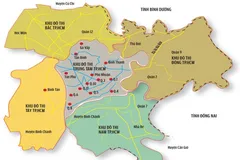
Still Heavily Reliant on Bank Credit
For years, the real estate sector has leaned heavily on bank credit as its primary source of capital. According to the State Bank of Vietnam (SBV), total outstanding credit for real estate has reached VND 3.48 quadrillion (roughly USD 140 billion). In 2024 alone, credit for real estate grew by 16.11%—outpacing the national credit growth rate of 15.08%.
Consumer loans make up around 60% of this total, while business-related real estate loans account for the remaining 40%. In Ho Chi Minh City, the country’s financial hub, the numbers are even more striking. Real estate credit stands at nearly VND 1.1 quadrillion—about 28% of the city’s total outstanding loans. As of February 2025, real estate credit in HCMC had already increased by 1.15% compared to year-end 2024.
While these figures indicate continued interest and investment in the sector, they also highlight a long-standing vulnerability: an overdependence on short-term bank loans for a long-term asset class. Vietnam’s banks primarily mobilize short-term deposits, yet real estate development typically requires medium- to long-term financing.
The gap is growing. As of late March 2025, the difference between credit disbursement and capital mobilization in the banking system has widened to VND 1.1 quadrillion. Banks are increasingly having to dip into their own capital and borrow from the SBV to keep up with lending demand.
Time to Unblock Other Capital Channels
According to Dr. Truong Van Phuoc, former Acting Chairman of the National Financial Supervisory Commission, the solution lies in allowing the free market to work. “We’ve chosen to follow a market economy,” he says. “That means lenders—especially banks—must allocate capital responsibly, while macroeconomic policy should create incentives aligned with national goals.”
While Dr. Phuoc acknowledges that bank credit will always play a role, he believes the real question isn't how much banks should lend, but rather why other channels aren’t being activated.
“Why are we only talking about bank loans for real estate?” he asks. “What about corporate bonds? Why haven’t we reformed the framework for individual bond issuance to make it safer for both companies and investors?”
He also points to other underutilized funding avenues: public-private partnerships (PPPs), State Capital Investment Corporation (SCIC) funds, and socialized capital sources. “Real estate can’t just rely on banks. The capital market needs to function properly. That means fixing the institutional framework not only for real estate, but for finance as a whole,” he adds.
A Market with Untapped Potential
Dr. Nguyen Duc Kien, former Deputy Chair of the National Assembly’s Economic Committee and Head of the Government Advisory Group, echoes this sentiment. “In any healthy market economy, bank credit is just one of several capital sources,” he notes. “Real estate businesses should be accessing capital through corporate bonds, IPOs, and the stock market.”
But that’s not happening—at least not yet.
Data from the first quarter of 2025 shows a disappointing picture for the bond market. From January to mid-April, total corporate bond issuance stood at VND 25.6 trillion, with 11 public offerings worth VND 23.1 trillion and three private placements totaling VND 2.5 trillion. However, none of these came from the real estate sector. Instead, all issuances were concentrated in the banking and securities industries.
Meanwhile, pressure is building. According to ratings agency VIS Rating, real estate developers face VND 110 trillion in bond maturities in 2025. Of that amount, VND 31 trillion is already in default or in late payment status—painting a worrying picture of financial strain.
Time for Reform, Not Rescue
Experts agree that the focus should not be on bailing out developers or flooding the market with cheap credit. Instead, the government needs to double down on institutional reform, strengthening investor protections and enabling more reliable capital mobilization.
“This isn’t about saving any particular company,” says Dr. Phuoc. “It’s about creating a well-functioning ecosystem—one where the market decides where money flows, and how much risk is acceptable.”
To do that, policymakers must move quickly to restore confidence in the bond market, streamline regulations for public-private projects, and encourage broader participation in capital markets. Until that happens, real estate firms will continue to rely heavily on short-term bank funding, limiting their ability to scale sustainably.
Looking Ahead
Vietnam’s real estate sector is still seen by many as a pillar of the economy—one that’s closely linked to employment, infrastructure development, and overall economic growth. But without a broader, deeper financial system supporting it, the market will remain prone to volatility and vulnerable to credit crunches.
Unlocking capital for real estate isn’t just a policy issue—it’s a structural one. It requires a shift in mindset, from dependency to diversification.
And as the data shows, the time to act is now.




















